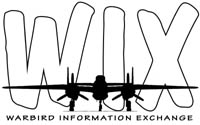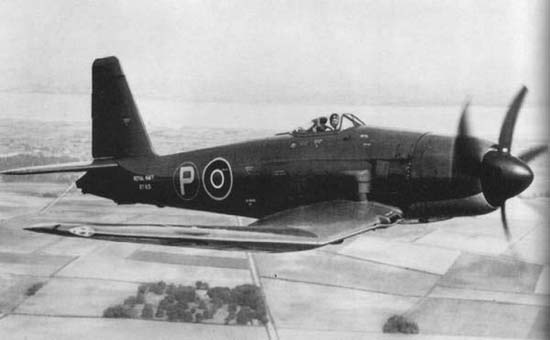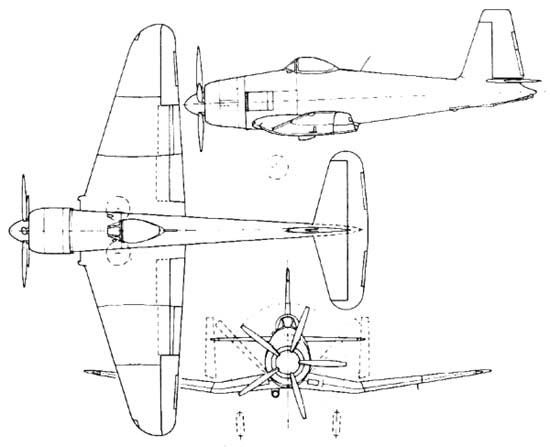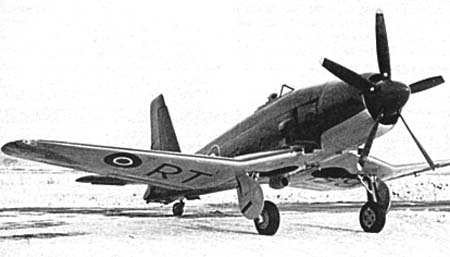MEMBER SITES

Warbird discussion forums
Warbirds-Online
Warbird News and commentary.
Warbird Registry
The histories of individual warbirds.
RESOURCE CENTERS
– U.S.A.A.F
– U.S. NAVY
– LUFTWAFFE
– JAPANESE
– RUSSIAN
– VIETNAM ERA
– ALLIED
OTHER SECTIONS
WHATS NEW
ARTICLES
STAFF
REVIEWS
PX STORE
FAQ
CONTACT US
SUPPORT THE SITE
LINKS
|
|
MAIN INDEX > EXPERIMENTAL/PROTOTYPES
BLACKBURN FIRECREST

Specifications
Type: Strike fighter
Origin: Blackburn Aircraft
Designed by: N.A
Models: Prototypes
Crew: One
First Flight: April 1, 1947
Number Produced: 3
Powerpnat:
Model: Bristol Centaurus 59
Type: 18-cylinder radial
Number: One Horsepower: 2,475 hp
Dimensions:
Wing span: 44 ft 11½ in (13.71 m)
Length: 39 ft 3½ in (11.98 m)
Height: 14 ft 6 in (4.42 m)
Wing Surface Area: 361.5 ft² (33.60 m²)
Weights:
Empty weight: 10,513 lb (4,779 kg)
Loaded weight: 15,280 lb (6,645 kg)
|
|
Performance:
Maximum speed: 380 mph (612 kph) at 19,000 ft (5,790 m)
Cruise speed: 213 mph (343 kph) at 15,000 ft (4,600 m)
Range: 900 mi (1,450 km)
Service ceiling: 31,600 ft (9,630 m)
Rate of climb: 2,500 ft/min (12.7 m/s)
Barrel Armament:
2× .50 in M2 Browning machine guns under or in wing (not fitted to prototypes)
External Ordnance:
Rockets:
8× RP-3 rockets on underwing rails
Bombs:
1× 2,097 lb (951 kg) torpedo, or
2× 250 lb (110 kg) bombs, one under each wing, in place of torpedo
|
The Blackburn B-48 Firecrest or YA.1 was a single-engine naval strike fighter built by Blackburn Aircraft. It was a development of the troublesome B-35 Firebrand. It was designed to Air Ministry Specification S.28/43, for an improved Firebrand more suited to carrier operations.
Design:
Operational experience had found that Blackburn's Firebrand strike fighter to be far from suited to carrier operations. Particularly, the pilot sat behind the wing trailing edge, looking over a very long and wide nose, which gave a particularly poor view for landing. In October 1943, Blackburn's design staff, lead by G.E. Petty, started work on a development of the Firebrand, with a redesigned wing and improved pilot view, which lead to Specification S28/43 being issued by the Air Ministry on 26 February 1944 covering the new aircraft.

The new design, the Blackburn B-48, was known unofficially by Blackburns as the "Firecrest" but always known by its Specification number by the Air Ministry and Navy. The Firecrest had a redesigned, inverted gull wing of laminar flow aerofoil section and moved the pilot forwards and raised his position so that he was now looking over the leading edge, and down the nose, rather than along it. Four Fowler flaps were fitted to give good low-speed handling for landing and the wing had retractable dive brakes on both surfaces. The wing folded in two places to allow storage in carrier hangars. In other respects, the Firecrest was a conventional monoplane design with a tailwheel undercarriage and particularly clean lines.
The first prototype (RT651) was rolled out in February 1947, and made its maiden flight on 1 April that year. By this time, however, the Air Ministry had concluded that the Firecrest would not be adequate for the Strike role, for which the Westland Wyvern was preferred, and work on the complete but unflown second and third prototypes was suspended in November. Later in the month, however, the third prototype was allocated to tests of powered aileron controls, as testing of the first prototype had shown that while adequate at cruise speed, the ailerons were heavy both at low and high speed. The second prototype was allocated to structural testing.

The third prototype made its maiden flight in early 1948, While the Firecrest was faster than the Firebrand, and gave its pilot a much better view from the cockpit, it was otherwise disappointing, with Test pilot Eric Brown claiming that the Firecrest was even less manoeuvrable than the sluggish Firebrand, while the powered ailerons gave lumpy controls, leading to instability in turbulent air.
The Firecrest had been rendered obsolete by the arrival of gas turbine engines, and while Blackburn did draw up proposals for turboprop powered derivatives of the Firecrest, but these were unbuilt, with orders going to Westland for the Wyvern. The two flying prototypes remained in use until 1949, being sold back to Blackburn in 1950, and were later scrapped.
Sources:
Wikipedia
MAIN INDEX > EXPERIMENTAL/PROTOTYPES
|
|

A WARBIRDS RESOURCE
GROUP WEBSITE
HOW CAN I
SUPPORT
THIS SITE?
(Click Here For Info)
|